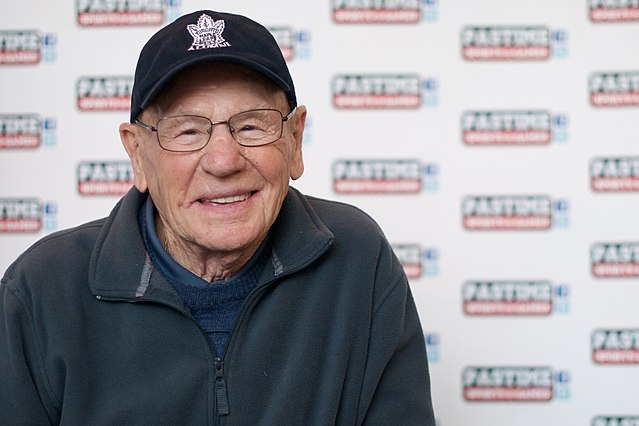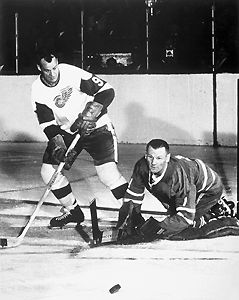
Early Life
Johnny Bower grew up during the Great Depression in Prince Albert, Saskatchewan. He was one of nine children born to John and Betty (née Bower) Kiszkan. Most families in Prince Albert struggled financially during the 1930s, and the Bowers were no different. Despite tough economic times, Bower remembered his childhood as being full of friendship and fun. Prince Albert was the ideal place for an aspiring young hockey player. In his autobiography, The China Wall, Bower recalls long frigid winters and an abundance of ice surfaces. Playing forward never appealed to him, and he found himself spending more and more time goaltending.
Bower and his friends improvised their hockey equipment, using old mattresses for goalie pads, frozen horse manure “road apples” for pucks and poplar branches for sticks. Few of them had access to skates, and even when they did, the skates were often ill-fitting. Kids carried their makeshift equipment with them all the time, and impromptu games would break out on the roads to and from school. After a long day of shinny, Bower and his friends would gather around the radio and listen to Foster Hewitt live from the “gondola” in Maple Leaf Gardens. Everyone was cheering for the Toronto Maple Leafs except the young Bower, who idolized the Boston Bruins goaltender Frankie Brimsek, nicknamed “Mr. Zero” for his shutout streaks.
Military Service
As a teenager in Prince Albert, Bower was part of a local army reserve unit. Bower was 15 when the Second World War broke out in 1939. He was sent to Vernon, British Columbia, as part of the Prince Albert Volunteers, and remained there for over two years to complete his military training. While there, he played goal for the Vernon Military All-Stars, who won the provincial intermediate championship for the 1942–43 season.
Later in 1943, Bower was posted overseas to Guildford, England, where he served as a gunner with the Queen’s Own Cameron Highlanders. However, he was hospitalized with a serious respiratory infection, and he had also developed rheumatoid arthritis in his hands. He never saw action. Considered unfit for combat, he was eventually sent home, and received an honourable medical discharge. By January 1944 he was playing hockey again, appearing in an exhibition game for a Prince Albert All-Star team. He then played for the Prince Albert M&C Warhawks and helped the team win the 1944 Western Canada Intermediate championship.
American Hockey League Career and NHL Debut
During the 1944–45 season, Bower played for the Prince Albert Black Hawks in the Saskatchewan Junior Hockey League, leading the league with a 2.57 goals-against average. However, he first had to prove he was still young enough to play junior hockey, after four years in the army. When he produced his birth certificate, it became clear that Bower had lied about his age when he enlisted, as he would have been only 15 years old at the time.
The following season (1945–46), Bower was scouted into the Cleveland Barons of the American Hockey League (AHL). After his first season as a professional, he legally changed his last name from Kiszkan to Bower, his mother’s maiden name. Although he joked at the time that the change made his name easier for sportswriters, it may have had more to do with his parents’ separation.
Bower played eight seasons with Cleveland (1945–46 to 1952–53) and was on three Calder Cup championship teams during that period. In the summer of 1948, after Bower won his first championship with the Barons, he took a job as an assistant golf pro at a course in Waskesiu Golf Club, north of Prince Albert. There he met a young woman from Saskatoon, named Nancy. Johnny and Nancy were married in Cleveland on 3 November 1948, during a Baron mid-season break.
After several more seasons with the Barons, the big leagues began to court Bower. In 1953–54, he made his NHL debut with the New York Rangers. At the time, the Rangers were a bottom-tier team and they hoped that Bower could help secure a spot in the playoffs. Although the team didn’t make it to the post-season, it was a successful year for Bower. He played all 70 games of the season and had five shutouts. His 182 goals-against remained the club’s best total until 1970–71. His 29 wins tied the club record for rookie goalies set in 1941–42 and it would not be beaten until 2005–06. It was also a significant year for Bower and wife Nancy, as they welcomed their first child, John, in March 1954.
Bower then returned to the minor leagues for another four seasons. He played one season for the Vancouver Canucks (1954–55), which was a Western Hockey League farm team for the Rangers at the time. The following season (1955–56), he returned to the American Hockey League to play for the Providence Reds. That season the Reds swept the Cleveland Barons, Bower’s former team, in the Calder Cup final. Bower was the first goalie to be awarded the Les Cunningham Award for most valuable player in the AHL. After another successful season in Providence, Bower returned to Cleveland. He had a strong season (1957–58) with the Barons, earning his third Hap Holmes Memorial Award for best goals-against-average, and was selected as an All-Star for the sixth time. Bower still holds the AHL record for most wins for a goaltender (359).
Toronto Maple Leafs
Bower was 33 years old when the Toronto Maple Leafs drafted him for the 1958–59 season. While he was hesitant to leave the security of his minor league position, he also felt compelled to fulfill his childhood dream of winning the Stanley Cup. In his first season, he led the last-place Leafs to a Stanley Cup final. Bower quickly established a reputation as a hard worker who was unflappably calm under pressure.
Bower received the Vezina Trophy, awarded to the NHL’s best goaltender, for the first time in 1961. The following season, the Leafs won the Stanley Cup, fulfilling Bower’s childhood dream. His goaltending led the Leafs to three consecutive Cups (1962–64). After the third victory in 1964, the Leafs added goalie Terry Sawchuk to their roster. Bower and Sawchuk shared the Vezina trophy in 1964–65, their first season playing together.
Bower was 42 years old in 1967, when he celebrated his fourth and final Stanley Cup victory. He retired after the 1969–70 season, at the age of 45 — the oldest goalie to ever play in the NHL. In his last 10 seasons Bower was the oldest player on the Maple Leafs roster and in the league. During his 12 seasons with the Leafs, Bower played in four All-Star games.
For most of his career, Bower did not wear a goaltender mask, only donning one in his last season. His face was a testament to that — he endured cuts and scrapes and missing teeth, especially as a result of his risky trademark “poke check” move. The poke check, an aggressive defensive maneuver mastered by Bower, involves using the blade of the stick to knock the puck away from an approaching player.
DID YOU KNOW?
In 1965, Bower released a recording of a children’s Christmas song, “Honky the Christmas Goose,” which sold 40,000 copies — then a Canadian record. CBC producer Chip Young, who had written the song with composer Orville Hoover, wanted a Maple Leaf to record it as a single and Bower agreed. He was joined on the record by his 11-year-old son and five neighbourhood children; the group was known as Johnny Bower with Little John and the Rinky Dinks. For two weeks in December 1965, it was the most requested song on Toronto’s 1050 CHUM, displacing the Beatles’ “Day Tripper/We Can Work It Out.”
Later Life and Honours
Following Bower’s retirement as a player, he remained with the Leafs organization as a scout and coach. Even after his official retirement from the Leafs organization in 1990, he continued to make public appearances on behalf of the franchise. Bower was known for his generous spirit and was deeply involved in charity work, including hospital foundations and veterans’ causes. In 2006, Bower was named NHL Alumni Man of the Year for his community service. A park was named after him in Mississauga, Ontario, and he has been featured on a Canada Post stamp and a $10 Canadian silver coin. He was inducted into the Hockey Hall of Fame in 1976 and was given a star on Canada’s Walk of Fame in 2007. Bower is also a member of Canada’s Sports Hall of Fame, the American Hockey League Hall of Fame, the Saskatchewan Sports Hall of Fame, the Ontario Sports Hall of Fame, the Prince Albert Sports Hall of Fame and the Etobicoke Sports Hall of Fame. In 2016, the Toronto Maple Leafs retired Bower’s number No. 1 jersey.

Bower died from pneumonia in December 2017, at the age of 93. He left behind Nancy, his wife of almost 70 years, as well as their three children, John, Cynthia and Barbara, eight grandchildren and six great-grandchildren. In January 2018, the Toronto Maple Leafs hosted a Celebration of Life at the Air Canada Centre.

 Share on Facebook
Share on Facebook Share on X
Share on X Share by Email
Share by Email Share on Google Classroom
Share on Google Classroom





